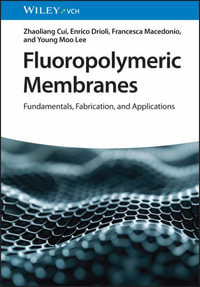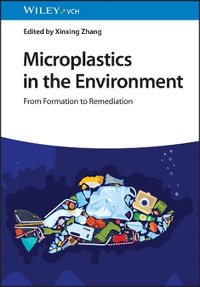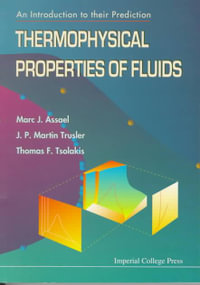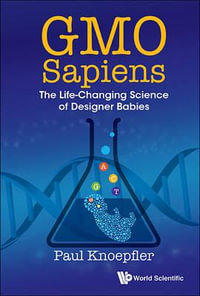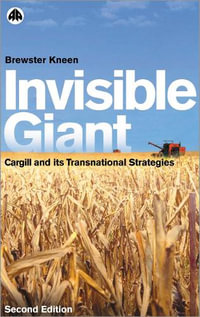
Solvent Extraction
Classical and Novel Approaches
By: Vladimir Kislik
Hardcover | 23 September 2011 | Edition Number 1
At a Glance
576 Pages
22.9 x 15.2 x 3.18
Hardcover
RRP $253.95
$191.75
24%OFF
or 4 interest-free payments of $47.94 with
orAims to ship in 5 to 10 business days
The main challenge in modern solvent extraction separation is that most techniques are mainly empirical, specific and particular for narrow fields of practice and require a large degree of experimentation. Thisÿconcise and modernÿbook provides aÿcomplete overview of both solvent extraction separation techniques andÿthe novel and unified competitive complexation/solvation theory. This novel and unified technique presented in the book provides a key forÿa preliminary quantitativeÿprediction ofÿsuitable extraction systemsÿwithout experimentation, thus saving researchers time and resources.
- Analyzes and compares both classical and new competitive models and techniques
- Offers aÿnovel and unified competitive complexation / solvation theory that permits researchersÿto standardize someÿparameters, which decreases the need for experimentation at R&D
- Presents examples of applications inÿmultiple disciplines such as chemical, biochemical, radiochemical, pharmaceutical and analytical separation
- Written by an outstanding scientist who is prolific in the field of separation science
| Preface | p. xi |
| Introduction | p. xiii |
| Conventional (Classical) Principles and Practice of Solvent Extraction | |
| Modern (Classical) Fundamental Principles of Solvent Extraction | p. 3 |
| Introduction | p. 5 |
| Solvent Extraction By Solvation | p. 5 |
| Solvent Extraction with Chemical Reactions (By Complexation) | p. 12 |
| Driving Forces of Solvent Extraction | p. 15 |
| Influence of Kinetics Factors | p. 17 |
| Selectivity | p. 34 |
| Factors Affecting Extraction Process | p. 36 |
| Module Design Considerations | p. 49 |
| Experimental Determination of Distribution Ratios | p. 55 |
| Summarizing Remarks | p. 58 References |
| Principles of Solvent Extraction of Organic and Mineral Acids | p. 69 |
| Introduction | p. 69 |
| Extraction of Acids by Carbon-Bonded Oxygen-Donor Extractants and Substituted Hydrocarbon Solvents | p. 71 |
| Phosphorus-Bonded Oxygen Donor Extractants | p. 85 |
| Aliphatic Amine Extractants | p. 89 |
| Extraction of Strong (Inorganic) Acids | p. 98 |
| Summarizing Remarks | p. 102 References |
| Chemistry of Metal Solvent Extraction | p. 113 |
| Introduction | p. 114 |
| Metal Extraction by Cation Exchangers (Acidic Extractants) | p. 114 |
| Metal Extraction by Anion Exchangers (Ion Pair Formation) | p. 27 |
| Extraction Through Formation of H-Bonding and Solvating Complexes | p. 135 |
| Extraction Through Mixed Complex Formation | p. 144 |
| Extractable Complexation of Monovalent Metals | p. 150 |
| Extraction with Aqueous Biphasic Systems | p. 151 |
| References | p. 153 |
| Engineering Development of Solvent Extraction Processes | p. 157 |
| Introduction | p. 157 |
| Extraction Stage | p. 159 |
| Stripping Organic Solutions | p. 169 |
| Extraction Efficiency | p. 170 |
| Equipment Design for Continuous Extraction-Stripping Processes | p. 173 |
| Solvent Losses | p. 182 |
| Economical Considerations | p. 183 |
| Problems with Scale-Up to Industrial Systems | p. 183 References |
| Examples of Application of Solvent Extraction Techniques in Chemical, Radiochemical, Biochemical, Pharmaceutical, Analytical Separations, and Wastewater Treatment | p. 185 |
| Introduction | p. 188 |
| xtraction in Hydrometallurgy (Metals Extraction) | p. 189 |
| Solvent Extraction in Nuclear Chemistry and Technology | p. 218 |
| Solvent Extraction in Analytical Chemistry | p. 239 |
| Application of Solvent Extraction in Biochemical and Pharmaceutical Separations | p. 273 |
| Application of Solvent Extraction in Organic and Biofuels Separation | p. 278 |
| Solvent Extraction in Recovery of Waste and Wastewater Treatment | p. 284 |
| References | p. 297 |
| Novel Competitive Complexation/Solvation Theory(CCST) of Solvent Extraction: Principles and Practice | |
| Backgrounds of the Competitive Complexation/ Solvation Theory of Solvent Extraction | p. 317 |
| Introduction | p. 317 |
| Complexation Through the H-Bonding and Proton Transfer | p. 317 |
| Distribution Isotherm | p. 319 |
| Modified Competitive Preferential Solvation Theory | p. 323 |
| Electronic Acid-Base Theory and Amphoterity | p. 327 |
| Aggregation | p. 328 |
| References | p. 329 |
| Competitive Complexation/Solvation-Theory of Solvent Extraction: General Mechanisms and Kinetics | p. 335 |
| Basic Statements | p. 335 |
| Extraction Systems with Low Solute Concentrations in Organic Phase | p. 336 |
| Systems with Medium Concentrations of the Solute | p. 345 |
| Systems with High Solute Concentrations | p. 348 |
| Comparison of Conventional and Presented Theories Description | p. 350 |
| Summarizing Remarks for the CCST | p. 351 |
| References | p. 352 |
| CCST in Engineering Design, Procedures, and Calculations | p. 355 |
| Introduction | p. 355 |
| Engineering Considerations in Experimental Investigation of CCST | p. 356 |
| Experimental Techniques for the Presented Theory | p. 358 |
| Determination of Extraction Constant and its Comparison with CCST Affinity Constant Ratios | p. 361 |
| Analytical Methods Used for the CCST Verification | p. 363 |
| Transferability of the Values of Affinity Constant Ratios | p. 364 |
| References | p. 364 |
| The CCST in Solvent Extraction of Acids by Amine-Based Extractants | p. 367 |
| Introduction | p. 367 |
| Acid-Amine Systems in the CCST Interpretation | p. 372 |
| The Systems with Active Solvent as an Additive | p. 381 |
| Experimental Application of the CCST in Carboxylic Acids Extraction | p. 384 |
| Summarizing Remarks | p. 395 |
| References | p. 397 |
| Competitive Complexation/Solvation Theory in Metal Solvent Extraction | p. 399 |
| Introduction | p. 399 |
| CCST Basic Statements | p. 400 |
| Mathematical Supplement for the CCST in Metal Extraction | p. 415 |
| Experimental Verification of the CCST Approach | p. 423 |
| Summarizing Remarks | p. 427 |
| p. 428 | |
| Final Remarks on the Competitive Complexation/ Solvation Theory of Solvent Extraction and its Application | p. 433 |
| Modern and Future Trends in Fundamentals and Applications of Solvent Extraction | |
| Modern and Future Trends in Fundamentals of Solvent Extraction | p. 439 |
| Introduction | p. 439 |
| Novel Molecular Models Theoretical Approach | p. 440 |
| Low Energy Reactions Measurement | p. 442 |
| Expected Advances in Kinetics Studies | p. 442 |
| Supramolecular (SUPRAS) Theoretical Approach | p. 443 |
| References | p. 449 |
| Advances in Development of Solvents for Liquid-Liquid Extraction | p. 451 |
| Introduction | p. 452 |
| Organic Solvents | p. 453 |
| Water as a Solvent | p. 457 |
| Renewable Water-Based Solvents | p. 458 |
| Ionic Liquids as Solvents for Extraction | p. 465 |
| Amphiphilic Compounds (Supramolecules) as Solvents in Solvent Extraction | p. 467 |
| Extraction by Microemulsion | p. 471 |
| Recovery of Reagents | p. 474 |
| Future Trends in the Development of New Solvents | p. 475 |
| Concluding Remarks | p. 477 |
| References | p. 478 |
| Recent Advances in Solvent Extraction Processes and Techniques | p. 483 |
| Introduction | p. 484 |
| Equipment Design and Scale-Up Considerations | p. 485 |
| Supercritical Fluid Extraction | p. 486 |
| Subcritical Water Extraction | p. 493 |
| Aqueous Two-Phase Systems | p. 498 |
| Extraction Processes with Ionic Liquids | p. 499 |
| Liquid Membrane and Nondispersive, Membrane-Based Solvent Extraction Techniques | p. 501 |
| Supramolecular-Based Extraction Techniques | p. 504 |
| Solid-Liquid Extraction Systems | p. 511 |
| Assisted Solvent Extraction | p. 513 |
| Extraction of Gas in Analytical Applications | p. 514 |
| References | p. 515 |
| Appendix | p. 525 |
| Index | p. 539 |
| Table of Contents provided by Ingram. All Rights Reserved. |
ISBN: 9780444537782
ISBN-10: 0444537783
Published: 23rd September 2011
Format: Hardcover
Language: English
Number of Pages: 576
Audience: Professional and Scholarly
Publisher: Elsevier Amsterdam
Country of Publication: GB
Edition Number: 1
Dimensions (cm): 22.9 x 15.2 x 3.18
Weight (kg): 0.96
Shipping
| Standard Shipping | Express Shipping | |
|---|---|---|
| Metro postcodes: | $9.99 | $14.95 |
| Regional postcodes: | $9.99 | $14.95 |
| Rural postcodes: | $9.99 | $14.95 |
How to return your order
At Booktopia, we offer hassle-free returns in accordance with our returns policy. If you wish to return an item, please get in touch with Booktopia Customer Care.
Additional postage charges may be applicable.
Defective items
If there is a problem with any of the items received for your order then the Booktopia Customer Care team is ready to assist you.
For more info please visit our Help Centre.
You Can Find This Book In

Chemical Engineering Design
3rd Edition - Principles, Practice and Economics of Plant and Process Design
Paperback
RRP $214.95
$148.50
OFF

Superconvergence
How the Genetics, Biotech, and AI Revolutions Will Transform our Lives, Work, and World
Hardcover
RRP $59.99
$51.75
OFF

Biofuels and Sustainability
Life-cycle Assessments, System Biology, Policies, and Emerging Technologies
Paperback
RRP $414.95
$313.25
OFF






